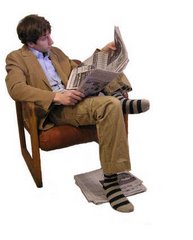So I made it back down to Kisumu with my cell phone as the only casuality. It was an awful trip and I plan on not repeating it. Back alone in my little house on the outskirts of this sprawling city, I found myself staring down the barrel of another empty weekend. To fill the void, I attempted to accomplish three goals. First, I went for a little run away from the city to a peninsula called Hippo Point. Lonely Planet remarks on its nice view of Lake Victoria, the eponymous hippo potential, and the nice little restaurant there that's popular with the expat community.
The view was clouded by morning mists, the hippos were grazing elsewhere, and the restaurant had burned down. Nevertheless, it was a pretty spot, and if I had the ability to disconnect that place from last year's shooting of the son of the researcher in whose house I'm staying, I might have lingered. The son is fine and does not appear emotionally scarred, but if the hippos weren't going to make an immediate and dramatic appearance, I was going home.
Second, I bought a new telephone. For those interested, the number is 0725 926 339, preceeded by the appropriate international and Kenyan codes. I'm not sure if the number will work, since immediately upon turning it on, I received a number of text messages clearly not intended for me (including one that reads "Baby gal am so grateful 4 wat u ave done 4 me ope day i get 2 repay u bt as always u wil always b in ma prayers gnit").
Third, I went to the Kisumu museum. The original museum building is a small room housing dusty exhibits of the sort common to dull museums worldwide. These included a number of stuffed birds and monkeys wired into unlifelike poses, a tableau depicting early tribal life, and a collection of ancient bowls and tools used for the storage and preparation of various grains. When I later left the museum, I wandered through the nearby marketplace, where wizened old women could be found selling clay and wooden bowls that were, as near as I could tell, identical in every way to the museum artifacts, with the distinction of being a thousand years younger.
More interesting were the various exhibits scattered around outside the museum proper. One was an avowedly accurate replication of a traditional Luo homestead. It featured a number of thatched mud huts in which a Luo man would live with his assorted wives and sons. Again, the exhibit was made somewhat less dramatic by the fact that the actual Luos living in the slums a few blocks away still live in very similar huts, albeit with less wives. However, I found the earnestness with which the exhibit was constructed to be touching. The inside of the huts were decorated with a few clay pots and other traditional artifacts, but were generally uninteresting; in one hut, however, I found one of the museum workers stuffing newly harvested bunches of bananas into the narrow neck of one of the pots. I can't imagine any of the handful of visitors to the very dark interior of the hut wondering whether there were any bananas still lodged inside the pots sitting in the corner, but I'm pleased to be able to report that the answer is yes. Other unexpected touches included the live sheep sitting in a huddled mass inside the traditional animal enclosure. I hope that they are taken out for grazing purposes at least on occasion.
Clearly not taken out for any purposes whatsoever were the other animal exhibits. These included a snake pit, a snake house, and a crocodile pool. Gracing the crocodile pool was a sign titled, "Danger Crocodile" that admitted that despite the fact that crocodiles were "useful and valuable," the museum strongly discouraged use of the stagnant pools in which they were kept for purposes of playing, washing, or bathing. The museum hoped that such measures would help curtail the incidence of death, and advised me to warn my children as such. The crocodiles looked like they were unlikely to cause many deaths, since they lay unmoving in their pools even as the other museum-goers prodded them with branches.
The snake house featured species from around Kenya. All were marked as "very poisonous" except for the enormous rock python and a certain mamba, the later of which was instead labeled as having an "extremely virulent neurotoxin." In related news, I nearly stepped on a large viper of unknown species in the highland forest last week. I did manage to take a picture, so hopefully we can ascertain its degree of deadliness at a later time.
Subscribe to:
Post Comments (Atom)


No comments:
Post a Comment